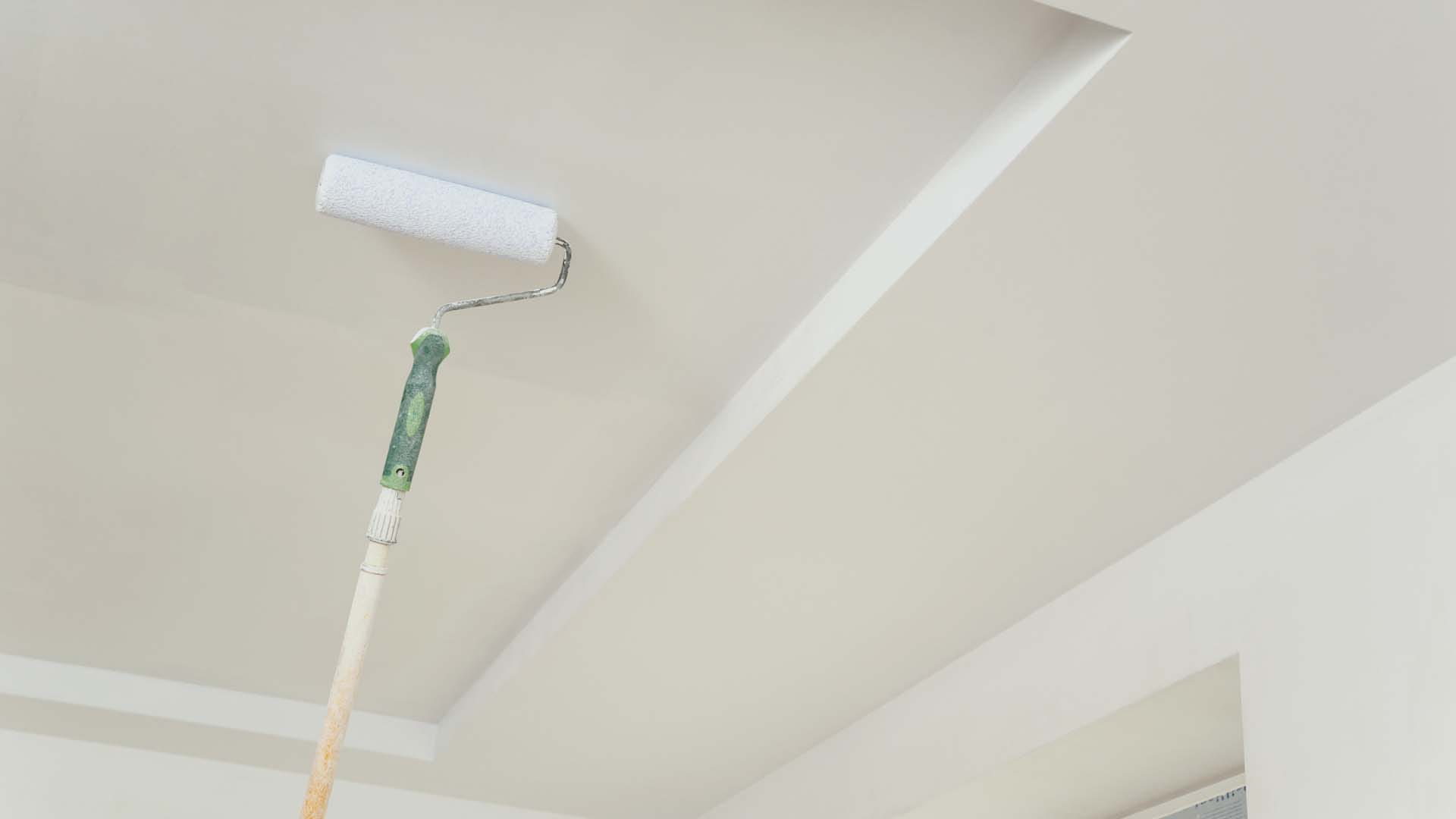How to paint your ceiling like a professional
We speak to a ceiling painting pro to get the best advice on preparing and painting your ceiling.

We speak to a ceiling painting pro to get the best advice on preparing and painting your ceiling.

Are you looking up at your ceiling and thinking that this is your next DIY project?
We're here to advise on the best way to paint that ceiling, with tips from trusted ceiling-painting pro, Artur Soszynski from Prime Projects in London.
Soszynski is a decorating expert who has been working on interiors for 20 years and specialises in bespoke and non-standard finishes including limewash, structural paints, Venetian stucco, and more. One of his latest ceiling-painting projects featured on NBC’s Open House.
Project overview
We’ll assume you have a smooth plastered ceiling. If you have, say, a textured / popcorn, swirled or a venetian plaster ceiling, these tips may not be for you.
A properly prepared 5m x 4m ceiling will take around two to three hours to paint two coats.
Estimated time: Two hours
Difficulty: Medium
Bear in mind ceilings are more difficult to paint than a wall, with additional equipment required and a greater toll on back and neck muscles.
Painting your ceiling is one of the most satisfying home projects, but it's little trickier to tackle than your average wall. You’ll definitely want to pace yourself. This particular DIY task gives the muscles in your back and neck a real workout, but really sets off a room that’s in need of a little brightening – you'll be surprised how dingy a ceiling can get over the years.
Let’s say you want to paint a ceiling that’s around 5m x 4m. Give yourself an hour to move and cover furniture. If your ceiling is in good condition, Soszynski estimates it will take you three hours to paint two coats.
That’s a lot of repetitive arm motion, even if you’re armed with a roller-painter tool, so taking breaks is a must.
With luck, you’re painting a ceiling that hasn’t suffered any water damage or other major issues. If your ceiling is damaged beyond cosmetic staining or cracking, you’ll want to have it fixed before you start painting.
You may use filler to repair cracks. If you have minor hairlines cracks, make them wider using a sharp knife edge. This will give the filler the room it needs to prevent it from falling out later.
Hairline cracks in corners can be tricky. You’ll need a cartridge gun filled with decorative caulk. Squeeze the caulk into the crack and use a wet finger or sponge to smooth.
Tip: If your ceiling has cosmetic stains, for instance, from cigarette smoke, before painting go over the stains with a stain-blocking primer. Soszynski uses Zinsser products but also recommends Dulux, Ronseal or Johnstone’s options. If your problem is hairline cracks, an alternative to filling cracks manually is using paints like Polycell and Zinsser Ceiling Pro 5-in-1. They are designed to cover minor cracks and prevent them reappearing.
Ever tried a ceiling paint calculator to figure out truly how much paint to buy, thus potentially saving a lot of money (or an extra trip to the DIY store)? B&Q does a good one.
Otherwise, type ‘ceiling paint calculator’ into Google and it will throw up some useful results. Your big price variable will be how many coats you need (or want).
Splatters can make painting ceiling a messy business. Also, your paint can will be open for longer than it would be if you were painting a wall, so you may want paint that is less splatter-prone and dries a bit slower.
Specialist ceiling paints are less prone to splattering and take longer to dry. Professionals lean towards Tikkurila Anti-Reflex 2, Teknos Teknoceiling and WRX Ceiling Paint.
But, as Soszynski tells us, plenty of ceilings are painted beautifully and professionally with just standard vinyl matt paint or matt emulsion, so don’t feel like you need to spend over the odds for a simple job.
The last thing you’ll want to do at the end of this process is step back to admire a ceiling full of roller marks. If you’re a roller brush beginner, here’s a quick video tutorial on roller brush technique to bring you up to speed.
You’ll get pointers on everything from how to get even coverage, how to avoid visible lap marks and roller brush storage.
The average ceiling height in the UK is 2.4m. If you have a more dramatic ceiling height one option is to buy (or borrow) a tall ladder.
Being familiar with ladder safety tips can be a real life-saver. The best tip for using a ladder is to never use one unless you absolutely have to. Secondly, it’s best to find out if you are a suitable candidate for using a ladder as it’s not the best tool to reach for if, say, mobility is a challenge.
Tip: Check out Ladder Grips, a ladder accessory designed to increase stability. Buying the right telescopic roller extension pole might also mean you don’t even need a ladder.
If your freshly plastered ceiling has never been painted before or there were holes to fill, your ceiling will need a ‘mist coat’ – this is the watered down paint that is used on fresh plaster first of all to help paint to stick. Skipping this vital step could result in damp or your paint eventually flaking and peeling off the ceiling.
You can create your own mist coat but some trial and error will go into preparing your homemade version. Check out this tutorial video all about painting mist coats on ceilings to get started.
Tip: Take the guesswork out of mixing your own mist coat with pre-prepared products like No Nonsense Trade Bare Plaster Paint Brilliant White or Zinsser Drywall Pro 2 in 1.

Higher quality paint brands like Little Greene and Farrow & Ball tend to have more pigmentation, so you may get away with fewer coats.
A good rule of thumb is two coats minimum, but you might need more depending on whether you’re going from a dark to light colour.
If you’re using white paint to refresh a white ceiling and it’s in reasonable condition, you might only need one coat of paint.

The clearer your room, the easier painting your ceiling will be. Move out as much furniture, art and accessories as you can. Once that’s done, cover the floors and anything else in the room with protective sheeting.
Your ceiling might have light fittings or other electrical fixtures that may need to be removed or covered with low-tack masking tape to protect them.
Start your prepping as early as you can in the day since fading light will make painting your ceiling like a pro that much harder.
If your plastered ceiling has been painted a few times before, it could benefit from being sanded to get rid of paint build-up.
The tool for the job is a pole sander, where drywall sanding sheets are attached to the long stem. After sanding, use a damp sponge to remove dust from the ceiling.
Tip: Sanding will improve the paint’s ability to bond with the ceiling and the finish will be smoother. Products like the Stanley Hand Sander are a good hand-held tool option for this task if you find it tricky to find or use a pole sander.
Giving your room a good clean before starting to paint is essential. Get rid of any dust and make sure all your surfaces are completely dry before cracking open the paint cans.

‘Cutting-in’ is a technique for making sure that where paint edges meet, you end up with sharp lines. This is the secret to a professional-looking finish, especially if you’re using a roller brush to paint your ceiling.
Roller brushes are designed for painting speed, not edge precision.
Cutting in will test your eyesight so make sure there is plenty of sunlight in your room before you get started.

Your roller brush technique has a big part to play on how professional your ceiling’s paint finish ends up looking. Once you start rolling the ceiling you won’t be able to stop until the entire surface is painted, so make sure you take a nice refreshing break before you start.
Attach a medium pile roller sleeve to your roller pole. Dip the roller into the large tray – you should have enough paint on your sleeve to cover an area of around 2 square metres.
It’s good technique not to let the edges of the area you are working on dry before starting the adjoining area.
For the first coat, paint across the width of the ceiling and let the paint dry. The drying time should be a minimum of four hours between coats, otherwise the paint may peel off later. For the second coat, paint across the length of the ceiling.
Tip: You may find investing in a lambswool roller cover might make the job of painting the ceiling easier and faster as it holds more paint than synthetic covers.
You can try a product like Axus Merino Sheepskin Roller Long Pile.
Soszynski suggests removing cutting in masking tape before the ceiling paint is completely dry. Removing the tape when the paint is fully dry can cause the paint to come away with the tape.
If you notice your original paint peeling away when you run over it with the roller, stop painting. Don’t be tempted to press on as you’ll only ruin your fresh paint with chips of peeled away paint.
You’ll need to paint your ceiling with anti-peel paint before applying your paint colour.










